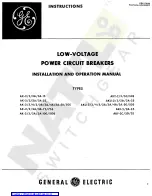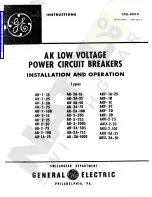
11
Instruction Booklet
IB015001EN
Effective June 2015
Power Xpert Solar DC
breaker recombiner
EATON
www.eaton.com
Recombiner insulation resistance testing
Maintenance before cleaning
Prior to cleaning, perform an initial Megger or DC test of the
Recombiner insulation, between phases and ground . Inspect for
symptoms that may indicate overheating or weakened insulation .
Record test readings . Refer to NEMA
®
publication AB-4, Guidelines
for
Inspection and Preventative Maintenance of Molded-Case Circuit
Breakers Used in Commercial and Industrial Application
.
Prior to testing, remove all control power fusing and connections
to products, which will be damaged in this test . This includes all
components with control wire fusing, transient voltage surge
suppression, surge protective devices, metering equipment,
and so on .
WARNING
TO PREVENT DAMAGE TO CONTROL CIRCUITS, WHEN MEGGERING
RECOMBINER, ISOLATE CIRCUITS FROM RECOMBINER SYSTEM BEFORE
BEGINNING THE MEGGER OPERATION. BE SURE TO RECONNECT THOSE
CIRCUITS AFTER MEGGER TESTS ARE COMPLETED.
DO NOT USE AC DIELECTRIC TESTING.
WARNING
DO NOT USE ALTERNATING CURRENT (AC) DIELECTRIC/ MEGGER TESTING.
DAMAGE TO COMPONENTS WILL OCCUR.
Cleaning
While the Recombiner is de-energized, remover dust and debris
from busbars, connections, supports, and enclosure surfaces . A
vacuum cleaner with a long nozzle will be of assistance . Wipe clean
with a lint-free cloth . Do not use solvents to clean equipment, as
damage to surfaces can occur .
Should the Recombiner be exposed to adverse conditions, such as
airborne contaminants, more frequent inspections and cleaning may
be required .
WARNING
DO NOT USE COMPRESSED AIR TO CLEAN OR BLOW OUT DEBRIS OR DUST
IN RECOMBINERS.
Use of compressed air to clean or blow out debris in Recombiners
may imbed the contaminants within overcurrent devices, and other
components . Damage to insulation and other surface materials can
occur . Do not use compressed air in cleaning .
Recombiner insulation resistance testing
Maintenance after cleaning
After cleaning, perform a second Megger or DC test of the
Recombiner insulation between phases and ground .
Prior to testing, remove all control power fusing and connections
to products, which will be damaged in this test . This includes all
components with control wire fusing, and so on .
WARNING
TO PREVENT DAMAGE TO CONTROL CIRCUITS, WHEN MEGGERING
RECOMBINER, ISOLATE CIRCUITS FROM RECOMBINER SYSTEM BEFORE
BEGINNING THE MEGGER OPERATION. BE SURE TO RECONNECT THOSE
CIRCUITS AFTER MEGGER TESTS ARE COMPLETED.
DO NOT USE AC DIELECTRIC TESTING.
WARNING
DO NOT USE ALTERNATING CURRENT (AC) DIELECTRIC/ MEGGER TESTING.
DAMAGE TO COMPONENTS WILL OCCUR.
A test resulting in readings at or above 1 mega ohm is satisfactory .
Compare these test readings with prior readings and retain with
previous testing for future comparisons . Trends of lowered insulation
resistance are signs of potential problems . A Recombiner Inspection
Log form is provided in
Appendix B
to record readings .
Bus and cable connections
1.
Inspect busbar and cables for visible damage .
2.
Visually inspect connections for overheating and damage .
3.
All busbar and cable connections should be checked and
torqued in accordance with labeling on the Recombiner .
Refer to
Appendix A,
Table 1
for torque values .
4.
Inspect for broken wire strands and pinched or damaged
insulation on cable connections .
Insulation
All busbar and structure insulation in the Recombiner, including bus
supports, bus shields, bus bracing, insulating barriers, and so on,
should be visually checked for damage . Replace damaged parts . The
life of insulation material is dependent on keeping the material dry
and clean .
Overcurrent devices
Maintenance instructions and field-testing for overcurrent devices are
included with the instruction leaflet for each device within a family .
One instruction leaflet per frame or family type was included with this
installation booklet inside the Recombiner . Refer to the leaflet on each
device . If leaflets are missing, contact Eaton for replacement .
Circuit breakers
Visually inspect circuit breakers for signs of discoloration, cracking,
scorching, overheating, or broken parts . Exercise the breaker
operating mechanism, making sure it is opening and closing .
A breaker showing signs of any one of these issues should be
replaced . Refer to NEMA publication AB-4,
Guidelines for Inspection
and Preventative Maintenance of Molded-Case Circuit Breakers
Used in Commercial and Industrial Applications.
Fusible overcurrent devices
Visually inspect the switching mechanism and fuse connections .
Visually inspect the fusible devices for signs of discoloration,
cracking, scorching, overheating, or broken parts . Replace any
worn parts or the entire switch .
Fuse replacement
DANGER
HAZARDOUS VOLTAGE WILL CAUSE SEVERE INJURY OR DEATH.
DE-ENERGIZE RECOMBINER PRIOR TO SERVICING FUSIBLE DEVICES.
Be sure the switch mechanism is turned to the OFF position before
attempting to remove fuses . Visually inspect the switch contacts,
blades, and mechanism to ensure that the mechanism is in the
OPEN/OFF position .
Check fuses to ensure that they are of the proper class, ampere,
voltage, and interrupting rating . Ensure that non–current-limiting
fuses are not used as replacements for current limiting fuses . Never
attempt to defeat rejection mechanisms that are provided to prevent
the installation of the incorrect class of fuse .






























